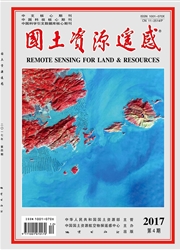

 中文摘要:
中文摘要:
复杂流域地物混杂,因受背景干扰,对混杂在不同背景地物中的目标地物很难用1个规则区分出来。基于Landsat8多波段影像,以湘江的Ⅰ级支流蒸水河流域和长江三角洲的3大城市为研究区,采用最大似然法进行初步分类;分析混杂地物的光谱特征,探讨区分混杂地物的决策规则,对水体、人工建筑、耕地、裸地、林地和裸岩等基本地物进行分类。结果表明,蒸水河流域分类的整体精度达到88.21%,高于监督分类精度(79.68%);其他3个长江三角洲城市的分类精度都在92%以上。所提出的混杂地物区分模型可以提高混杂在不同背景中的同类地物的分类精度。
 英文摘要:
英文摘要:
Mixed ground objects in complex basin are easily interfered by background,and foreground mixed in different ground objects is difficult to be distinguished by one rule. In this paper,the authors discuss the classification rule model of common ground feature in different mixed backgrounds. With Landsat8 images as the data source,level 1 tributary of Zhengshui River basin in Xiangjiang River basin and the three big cities of the Yangtze River delta as the study areas, the authors adopted the maximum likelihood method to conduct a preliminary classification. Based on analyzing the spectral characteristics of mixed feature,the authors built the classification decision tree of mixed ground feature to identify water,artificial construction,farmland,bare land,forest land and bare rock. The results obtained by the authors show that the overall accuracy of the Zhengshui River is about 88. 21%,which is higher than the supervised classification accuracy of 79. 68%,and the overall accuracy of other three cities along the Yangtze River is higher than 92%. It is shown that the classification model for mixed subjects can improve the accuracy of the same ground objects with different backgrounds.
 同期刊论文项目
同期刊论文项目
 同项目期刊论文
同项目期刊论文
 期刊信息
期刊信息
